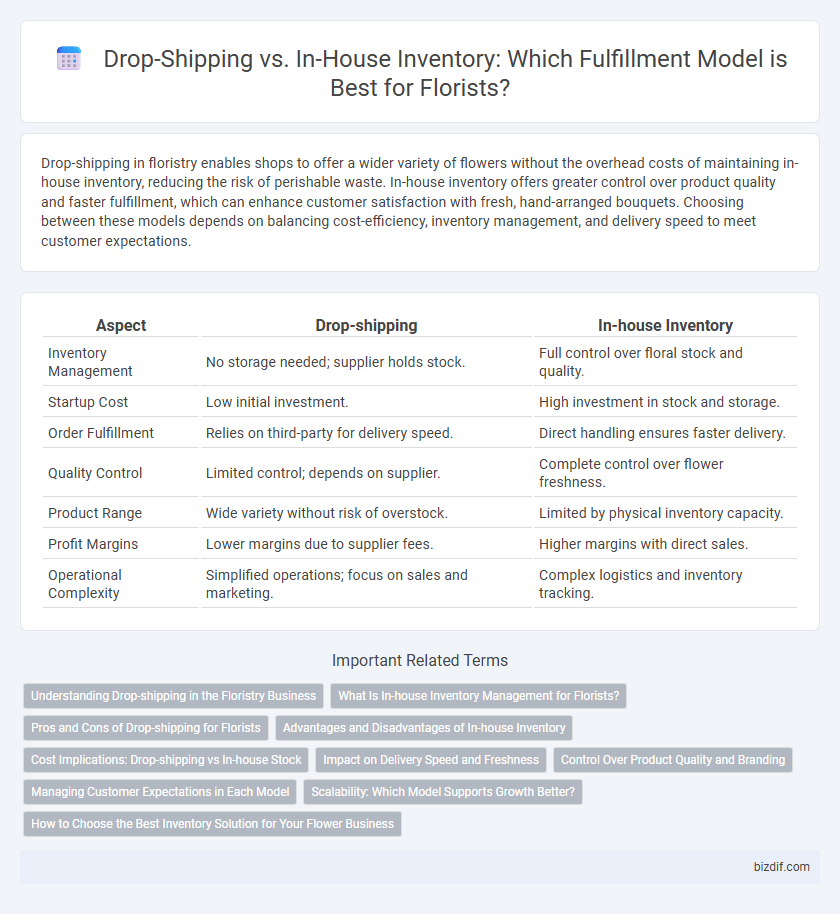Drop-shipping in floristry enables shops to offer a wider variety of flowers without the overhead costs of maintaining in-house inventory, reducing the risk of perishable waste. In-house inventory offers greater control over product quality and faster fulfillment, which can enhance customer satisfaction with fresh, hand-arranged bouquets. Choosing between these models depends on balancing cost-efficiency, inventory management, and delivery speed to meet customer expectations.
Table of Comparison
| Aspect | Drop-shipping | In-house Inventory |
|---|---|---|
| Inventory Management | No storage needed; supplier holds stock. | Full control over floral stock and quality. |
| Startup Cost | Low initial investment. | High investment in stock and storage. |
| Order Fulfillment | Relies on third-party for delivery speed. | Direct handling ensures faster delivery. |
| Quality Control | Limited control; depends on supplier. | Complete control over flower freshness. |
| Product Range | Wide variety without risk of overstock. | Limited by physical inventory capacity. |
| Profit Margins | Lower margins due to supplier fees. | Higher margins with direct sales. |
| Operational Complexity | Simplified operations; focus on sales and marketing. | Complex logistics and inventory tracking. |
Understanding Drop-shipping in the Floristry Business
Drop-shipping in the floristry business allows sellers to offer a wide range of fresh flowers without holding physical inventory, reducing overhead costs and minimizing waste from unsold stock. This model depends heavily on reliable suppliers and efficient logistics to ensure timely delivery and maintain floral freshness, which are critical for customer satisfaction. Florists leveraging drop-shipping must optimize supplier relationships and implement real-time inventory tracking to compete effectively in the market.
What Is In-house Inventory Management for Florists?
In-house inventory management for florists involves storing and maintaining floral stock directly at the retail location, allowing for immediate access to fresh flowers and supplies. This hands-on approach enables precise control over flower quality, arrangement customization, and timely order fulfillment. Managing in-house inventory also demands efficient tracking systems to reduce waste and optimize stock levels in response to seasonal demand fluctuations.
Pros and Cons of Drop-shipping for Florists
Drop-shipping allows florists to offer a wide range of floral arrangements without investing in large inventory, reducing upfront costs and minimizing the risk of unsold stock. However, reliance on third-party suppliers can lead to inconsistent product quality, longer delivery times, and less control over packaging and customer experience. This model suits florists seeking scalability and low inventory overhead but may compromise brand reliability and customer satisfaction.
Advantages and Disadvantages of In-house Inventory
In-house inventory in floristry offers immediate access to fresh flowers, ensuring superior quality control and personalized arrangements tailored to customer preferences. However, maintaining an in-house stock requires significant storage space, higher upfront costs for refrigeration equipment, and risks of product spoilage due to the perishable nature of floral products. The approach enables faster order fulfillment but limits scalability compared to drop-shipping models.
Cost Implications: Drop-shipping vs In-house Stock
Drop-shipping in floristry minimizes upfront inventory costs and reduces storage expenses, making it ideal for businesses with limited capital. In contrast, maintaining in-house stock requires significant investment in floral refrigeration, warehousing, and inventory management, increasing fixed operational costs. However, in-house inventory enables better quality control and faster delivery, potentially reducing long-term costs related to customer satisfaction and product spoilage.
Impact on Delivery Speed and Freshness
Drop-shipping in floristry often results in longer delivery times and reduced control over flower freshness due to reliance on third-party suppliers and shipping logistics. In-house inventory allows florists to maintain direct oversight of flower quality and expedite order processing, ensuring quicker delivery and optimal freshness. Managing stock internally also enables better handling of seasonal blooms, reducing the risk of wilted or damaged arrangements upon arrival.
Control Over Product Quality and Branding
In floristry, managing product quality and branding is more precise with in-house inventory, allowing direct inspection and customization of floral arrangements to maintain freshness and aesthetic standards. Drop-shipping limits control over the sourcing and handling of flowers, often leading to inconsistent quality and reduced brand differentiation. Florists prioritizing brand reputation typically prefer in-house inventory to ensure strict adherence to their quality criteria and customer expectations.
Managing Customer Expectations in Each Model
Managing customer expectations in floristry drop-shipping requires clear communication about delivery times, as orders often ship directly from suppliers, potentially causing delays or inconsistencies in product freshness and quality. In-house inventory allows florists greater control over stock quality and faster fulfillment, enabling more accurate promises on floral arrangement freshness and delivery windows. Transparency about sourcing and delivery processes in either model enhances customer trust and satisfaction, critical factors in a competitive floral market.
Scalability: Which Model Supports Growth Better?
Drop-shipping offers greater scalability for floristry businesses by eliminating the need for physical storage and allowing easy expansion of product variety without significant upfront costs. In-house inventory requires substantial investment in storage, handling, and staff, which can limit rapid growth and flexibility. Choosing drop-shipping enables florists to adapt quickly to market demand and scale operations efficiently.
How to Choose the Best Inventory Solution for Your Flower Business
Choosing the best inventory solution for a flower business depends on factors like cash flow, storage capacity, and customer demand patterns. Drop-shipping minimizes upfront costs and eliminates the need for physical storage by partnering with suppliers who ship directly to customers, making it ideal for startups or businesses with limited space. In-house inventory allows for greater control over product quality and faster order fulfillment, which benefits established florists aiming to provide personalized arrangements and immediate delivery.
Drop-shipping vs In-house Inventory Infographic

 bizdif.com
bizdif.com